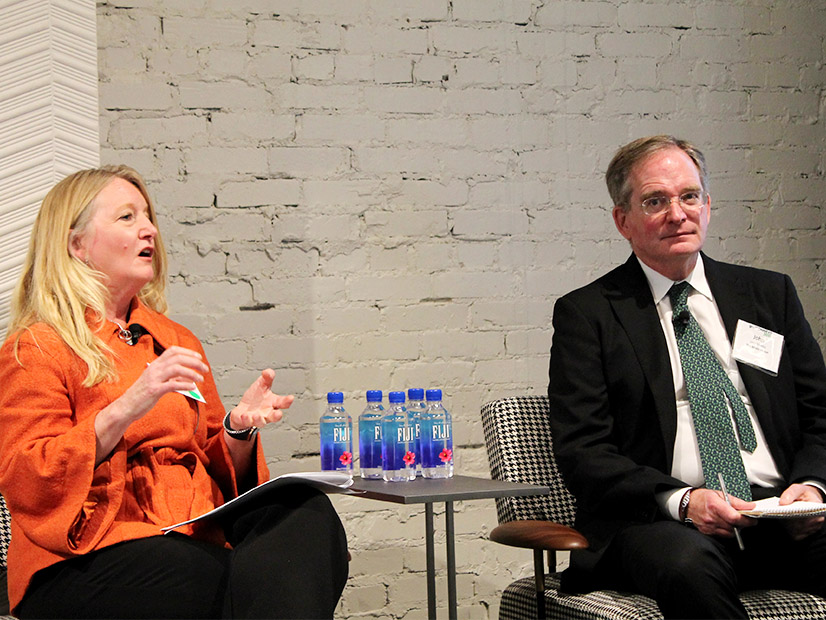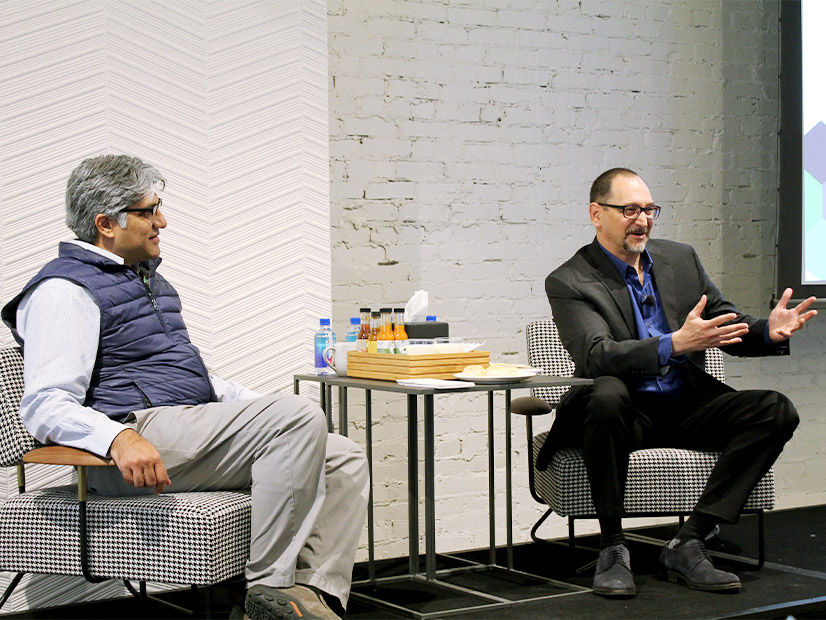
WASHINGTON — About 200 attendees of GridWise Alliance’s gridCONNEXT conference Wednesday listened as John Rhodes — former New York Public Service Commission chair, now special assistant to President Biden for climate policy — hyped the administration’s ambitious climate agenda, optimistic that its many goals could be achieved.
Rhodes spoke of a “zero-carbon electricity system by 2035 that’s reliable; that’s resilient to the weather that we know is getting more extreme; that is affordable and cost-effective for all Americans, especially low-income Americans, while creating millions of jobs.”
“That sounds like it’s Goldilocks; everything’s great,” Rhodes said. “The amazing thing is it’s actually possible. We just need to work to get there.”
Attendees were on board, but not just because they agreed with Rhodes’ rhetoric. There was a general sense of enthusiasm and optimism in the room — a dedicated event space run by Convene blocks from the White House — as they listened to panelists and speakers opine on a high-tech future in which everything is electrified, digitized and clean if the administration’s goals are achieved.
And like WIRES’ Fall Conference in late October, it was the first in-person event for many since the COVID-19 pandemic caused cancellations and transitions to online. (See Transmission Industry Hoping for Landmark Order(s) out of FERC ANOPR.) All attendees were required to be vaccinated and wear masks when not seated or eating. Additionally, attendees attached colored stickers to their nametag to indicate how comfortable they were with physical interaction: green meant hugs were OK; yellow for elbow bumps only; and red for social distancing. (This reporter did not see anyone hugging but chose yellow just in case.)
It was a sharp contrast to last year’s online-only event, in which speakers were obviously fatigued by both the pandemic and federal inaction on energy policy. (See Industry Eager for New Leadership on Tx, Climate.)
This year’s conference billed grid infrastructure as “the platform for decarbonization,” but for much of the conference, transmission took a backseat to everything it would enable. Attendees received a sales pitch from a Ford Motor Co. executive on its upcoming lineup of electric vehicles; an official from the Electric Power Research Institute spoke about a future in which all home appliances are grid-connected and controlled by the utility; and Maud Texier, Google’s carbon-free energy (CFE) lead, talked about how the company is aiming to procure 100% CFE at all times of the day, rather than just on an annual basis, by 2030.
The last of those presentations came the same day Biden ordered the federal government to procure half of its electricity from clean resources 24/7 by 2030. (See Biden Calls for Federal Procurement of 100% Clean Energy by 2030.) One of the slides in Texier’s presentation proclaimed that “24/7 CFE is the New Net Zero.”
Reality Check
Many speakers noted there was much to be done in the next decade or so to achieve Biden administration and company targets. Eric Dresselhuys, CEO of energy storage company ESS, was more blunt in his assessment. On a panel discussing approaches to decarbonization, Dresselhuys said “there’s no billions of dollars of investment that gets us anywhere close to what John Rhodes threw out; to total decarbonization by 2035. Round it to 2045; it doesn’t matter. The amount of work that has to get done is of a different scale.”
 ESS CEO Eric Dresselhuys | © RTO Insider LLC
ESS CEO Eric Dresselhuys | © RTO Insider LLCHe said conference panelists often say, “‘We’re trying to decarbonize the energy system,’ like that’s a static thing. … But we’re going to electrify everything: transportation, buildings, natural gas; we’re going to make everything electric. Then we’ve got about 100 million people around the planet who do not have access to electricity. … And then we have 2.3 billion people who don’t have access to clean cooking fuels, so we have to fix that problem. Oh, and by the way, the population is going to grow to about 9 billion people in the time frame we’re talking about.
“When you add that up, that is an electricity system that is two-and-a-half times the size of the global electricity system that it is today. And we’re going to do it all with no carbon. …
“We need smart people thinking about how the arc of this development is going to happen over the course of the next 20 [to] 50 years. I kind of feel like when someone says ‘we’re going to get to decarbonization by 2040, 2045, 2050’ — that triggers, because we’re human beings, ‘I’ve got time.’ … That’s just a natural way for our brains to think. I would tell you that we are massively behind. I think in the best-case scenario we are at a fraction — 20% would be generous — in the wave of change that we need to come anywhere close to come to the slow end [2050]. … I’m sorry folks, but 2035 is a pipe dream.”
Shah on the Hot Seat
Jigar Shah, director of the U.S. Department of Energy Loan Program Office, sat down with Lee Krevat, CEO of Krevat Energy Innovations, for a live edition of Krevat’s podcast “Climate Champions.”
Shah was co-founder and president of Generate Capital, which finances clean energy infrastructure projects. He was also a co-host of “The Energy Gang” podcast produced by Wood Mackenize, in which he could be contrarian and offer somewhat brash opinions.
Meanwhile, in addition to his energy consultancy work, Krevat performs improv and, judging by how he concluded the session, free-style raps.
 DOE’s Jigar Shah (left) and Lee Krevat, Krevat Energy Innovations | © RTO Insider LLC
DOE’s Jigar Shah (left) and Lee Krevat, Krevat Energy Innovations | © RTO Insider LLC
Together, they made for an entertaining duo as they ate hot-sauce covered biscuits, borrowing the premise of the YouTube series “Hot Ones,” in which celebrities are interviewed while eating buffalo wings that gradually increase in spiciness.
Krevat asked Shah what “transformational” technology he was most excited about. Shah talked at length about the ability of electric vehicles to provide backup power during an outage, especially as working from home continues to normalize. “People say, ‘Well is there going to be enough demand for electric vehicles?’ And I’m like, ‘Well is there enough demand for resiliency at home?’ … I think you will see long queues of people waiting for electric cars for no other reason than to back up their house.”
“Well I hope you’re right because…” Krevat began.
“Well I know I’m right!” Shah interjected.

